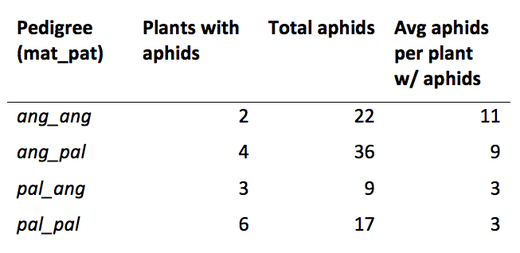These are my preliminary results after adding 2 aphids to each of the 80 plants in my experiment (20 of each variant) and checking on their survival after about a week:
The most interesting result is that aphids were able to survive on each variant, including Echinacea pallida (“pal_pal”). Lauren Hobbs and Hillary Lyon found that aphids did not survive on E. pallida in their experiment. If the aphids persist, it could challenge the species’ status as specialist. If they eventually die off, it could provide an insight into what makes E. pallida inhospitable to them.
Another result is that, while E. pallida had the most plants sustaining aphids and E. angustifolia the least, E. angustifolia had the highest average aphid load and E. pallida the lowest. Perhaps it is harder for aphids to colonize E. angustifolia but easier for them to persist once present. It is important to note that the plants in this experiment are only a year old, and so perhaps aphid survival is more affected by plant size than pedigree at this stage.
I am continuing my additions and observations with extra gusto, because I can’t wait to see if these trends bear out over repeated trials, or whether new ones will emerge.

